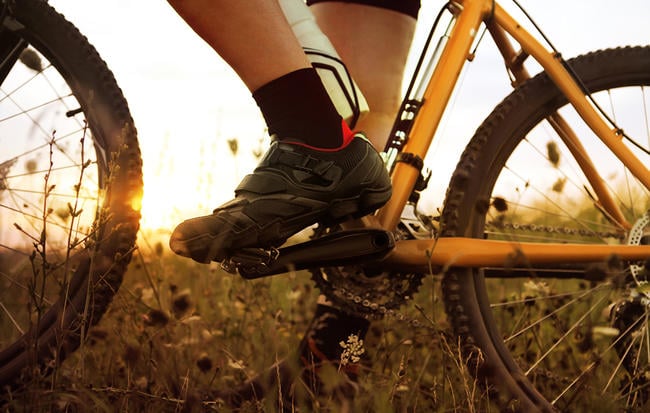Picture-perfect pedaling is more than pushing down on the pedals. It also involves pulling them up and around in an act that cyclists call pedaling circles. Ultimately, the goal is to eliminate any “dead spots” in your pedal stroke—at no point in each pedal stroke should your legs just be coming along for the ride; they should always be applying some pressure to propel you forward. The smoother and more evenly powered your pedal stroke, the more efficient it is, which allows you to ride faster with less exertion.
Here’s a great description I got from Todd Carver, a biomechanics expert at Retul in Boulder, Colorado, who found that when riders pedaled using the following technique, they were able to produce the same amount of power (as measured in watts) at a heart rate that was about five beats per minute lower. Simply put: They rode the same speed with less work. This is how to do it.
Align your legs.
Cyclists often refer to their legs as “pistons,” and with good reason. From head-on, your legs should look like pistons firing straight up and down. Your knees should not flap from side to side. Your hips should not rock or wobble. If you have a chance, watch yourself pedal on a spin bike or on your trainer in front of a mirror (or look down while pedaling in an open, no-traffic area). Your hips, knees, and ankles should line up throughout the pedal stroke. However, if you have bowed legs or other unique biomechanical characteristics, you may be an exception.
Drop your heel over the top.
You produce the most power at the top of the pedal stroke, when your foot is in the 12 o’clock position. Maximise your power in that position by dropping your heel slightly as you come over the top of the stroke. Aim to have the heel of your foot parallel or just a bit below parallel as you start the downstroke.
RELATED: The Perfect Pedal Stroke
Scrape your shoe.
As you come through the bottom of the stroke, engage your calf muscles and pull through, pointing your toes down slightly. Seasoned cyclists often recommend visualising scraping mud off the bottom of your shoe.
Bring your knees to the bars.
Everyone loses a little momentum and power on the upstroke. This is also where some people’s knees swing out to the side. Minimise that by consciously working on an active upstroke. As you begin to come across the top of the stroke, visualise driving your knee forward toward the bar. Be sure to keep your pelvis rock steady in the saddle throughout the whole stroke so there’s no wasted energy.
Now that you’ve gotten the hang of (or are at least practicing) spinning circles, let’s work on spinning them briskly. First, determine your current revolutions per minute. To do so, simply count how many times your right foot swings down toward the ground over 30 seconds and multiply by two.
RELATED: A Full Revolution
Your optimal pedal cadence depends upon myriad factors, including your muscle fiber composition, the type of cycling you’re doing, your gear, and even your age. When you spin at a very high cadence (say, 100 rpm or above) in a moderately light gear, you rely mostly on your aerobic, fat-burning energy system to do the work. Low cadences (say, below 80 rpm) in bigger gears use more muscle fibers and tap into the anaerobic system that burns glycogen (stored carbs). That’s why most of us find the pedaling sweet spot—where we’re neither frying our muscles nor wearing ourselves out—between those two ends of the spectrum. Most coaches recommend about 90 rpm. It’s not a magic number by any means, but it’s worth practicing picking up your pedaling speed if your cadence is below 80 rpm.


